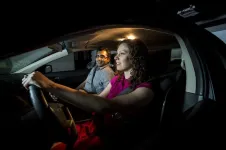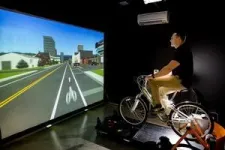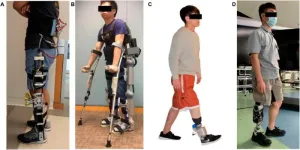(Press-News.org) CORVALLIS, Ore. – Laws that let bicyclists treat stop signs as yield signs lead neither riders nor motorists to act unsafely, according to a groundbreaking Oregon State University study.
The project by OSU College of Engineering researchers featured a novel experimental technique – linking separate bicycle and motor vehicle simulators – and the findings are important as more and more states consider bicycle rolling-stop legislation, said David Hurwitz, the study’s leader.
“It required fully connecting two independent simulators, running subjects in pairs simultaneously and having each subject interacting with an avatar of the other in a shared virtual world,” said Hurwitz, a transportation engineering professor. “We evaluated safety-relevant behaviors associated with laws stemming from the ‘Idaho stop,’ which was put on the books in 1982 but largely ignored around the country until not long ago.”
Starting in 2017, seven states have followed Idaho’s lead and enacted bicycle rolling-stop laws, including Oregon in 2019 and Washington in 2020. The others are Arkansas, Delaware, North Dakota, Oklahoma and Utah, and several additional states have considered legislation.
The laws vary in their specifics, but the basic idea is that cyclists are allowed to treat static stop signs as yield signs. The primary reason supporters like the laws is that they allow riders to keep their momentum, theoretically reducing intersection congestion and crash risk because the cyclists are getting through the intersection faster.
Nearly half of all bicycle-car crashes happen at intersections, Hurwitz said. In 2022, the latest year for which numbers are available, 1,105 bicyclists in the United States were killed in collisions with motor vehicles, according to the National Highway Traffic Safety Administration – a 13% increase from the 976 killed in 2021.
“The focus of previous research has been crash-data analysis and why riders are motivated to do a rolling stop even when it’s illegal in their state,” he said. “No one has looked at how well bicycle rolling-stop laws work, or what happens when you educate people about them. Our networked simulator study design let us evaluate driver and rider behavior and their understanding of the law.”
The study, which included Gonzaga University’s Rhonda Young, an OSU graduate, and the University of Idaho’s Kevin Chang, involved 60 people observed in pairs as they went through 16 “live-interaction” scenarios related to a bicyclist and motorist coming together at a four-way, stop-controlled intersection.
Previous research has indicated that drivers tend to be more aggressive toward cyclists when they think riders are breaking the law, Hurwitz said. In this study, time-space diagrams showed that after receiving education about the rolling-stop law, bicyclists preferred to yield rather than stop and went through intersections faster. Driving participants, meanwhile, approached intersections either more slowly or at a similar speed after being educated about the law.
“The findings suggest more outreach in regard to rolling-stop laws would be useful, and this research gives decision-makers information to support prospective legislative policies, set up educational programs and design robust enforcement practices,” Hurwitz said.
That’s particularly important in places like the Pacific Northwest, he added, noting Oregon and Washington have two of the largest percentages of bicycle commuters in the country. About 2% of Oregon workers get to their job via bicycle, and just under 1% of Washington workers.
The League of American Bicyclists’ 2017 Report on American Community Survey shows Portland with the second-largest number of bicycle commuters in the United States, ranking behind only New York City. There are about 22,000 bicycle commuters in Portland, and about 17,000 in Seattle.
OSU’s Jasmin Woodside, a master’s student and professional engineer, and Hisham Jashami, an assistant professor, also contributed to the study, which was funded by the U.S. Department of Transportation’s University Transportation Center Program and published in Transportation Research Part C.
END
Bicycle rolling-stop laws don’t lead to unsafe behavior by riders or motorists, research shows
2024-08-26
ELSE PRESS RELEASES FROM THIS DATE:
How a retracted paper affected the course of Alzheimer’s research (video)
2024-08-26
WASHINGTON, Aug. 26, 2024 — In June 2024, a landmark Alzheimer's research paper was retracted due to fraud allegations. Did we waste billions of dollars and thousands of hours of scientists’ time? Maybe not. There are now two potentially helpful drugs on the market targeting the subject of the paper: amyloid beta. This video breaks down the amyloid-beta hypothesis, the fraud itself and where we go from here.
Reactions is a video series produced by the American Chemical Society and PBS Digital Studios. Subscribe to Reactions and follow us on X, formerly Twitter @ACSReactions.
The American Chemical ...
Genotype Matters: Tailored screening for germline CHEK2 variants
2024-08-26
“In our study, we postulated that these differences were driven by three common low-risk (LR) missense variants: p.I157T, p.S428F, and p.T476M, all of which have a BC odds ratio of <1.4.”
BUFFALO, NY- August 26, 2024 – A new editorial was published in Oncotarget's Volume 15 on July 10, 2024, entitled, “Genotype matters: Personalized screening recommendations for germline CHEK2 variants.”
Recognized as a moderate-risk gene, CHEK2—responsible for encoding the CHK2 protein, ...
Interlimb and intralimb synergy modeling for lower limb assistive devices: Modeling methods and feature selection
2024-08-26
A research paper by scientists at Hainan University proposed FSS-eq2Seq as a 2-stage strategy for gait synergy modeling in lower limb assistive devices to achieve synergic and user-adaptive trajectories that improve human-machine interactions.
The new research paper, published on Jul. 03 in the journal Cyborg and Bionic Systems, indicatedSeq2Seq outperforms LSTM, RNN, and GRU in both interlimb and intralimb synergy modeling. Further, FS significantly improves Seq2Seq’s modeling performance.
The concept of gait synergy provides novel human-machine interfaces and has been applied ...
Darwin’s fear was unjustified: Writing evolutionary history by bridging the gaps
2024-08-26
Fossils are used to reconstruct evolutionary history, but not all animals and plants become fossils and many fossils are destroyed before we can find them (e.g., the rocks that contain the fossils are destroyed by erosion). As a result, the fossil record has gaps and is incomplete, and we’re missing data that we need to reconstruct evolutionary history. Now, a team of sedimentologists and stratigraphers from the Netherlands and the UK examined how this incompleteness influences the reconstruction of evolutionary history. To their surprise, they found that the incompleteness itself is actually not such a big issue. “It’s ...
Trends of heat-related deaths in the US, 1999-2023
2024-08-26
About The Study: This study found that heat-related mortality rates in the U.S. increased between 1999 and 2023, especially during the last 7 years. Although a study using data through 2018 found a downward trend in heat-related mortality in the U.S., this study is the first to our knowledge to demonstrate a reversal of this trend from 2016 to 2023. These results align with site-specific data analyzed in a global study that suggest increases in heat-related mortality. As temperatures continue to rise because of climate change, the recent increasing trend is likely to continue. Local authorities in high-risk areas should consider investing in the expansion of access to hydration centers ...
Transgender students more likely than cisgender peers to seek support from school staff, UW–Madison and NYU study finds
2024-08-26
MADISON – Transgender students are more likely to seek support from school staff and less likely to seek support from their parents when compared to their cisgender peers, according to a new study from researchers at the University of Wisconsin–Madison and New York University.
The study, published in JAMA Pediatrics, found among students who felt depressed or anxious, transgender students were 74% less likely than their cisgender peers to seek help from parents than from adults in schools. It also found transgender students were 25% less likely than cisgender students to seek support from ...
Longitudinal changes in youth mental health from before to during the COVID-19 pandemic
2024-08-26
About The Study: In this longitudinal cohort study of economically and racially diverse U.S. youth, there was evidence of differential susceptibility and resilience for mental health problems during the pandemic that was associated with prepandemic mental health and sociodemographic characteristics. These differences are critical to understand for recovery and may yield novel insights into causes of youth mental health problems.
Corresponding Authors: To contact the corresponding authors, email Courtney ...
Repetitive head impacts and perivascular space volume in former football players
2024-08-26
About The Study: In this cross-sectional cohort study of 170 former football players and 54 unexposed controls, larger perivascular space (PVS) volume was associated with greater exposure to repetitive head impacts (RHI). Additionally, PVS volume was associated with worse performance on cognitive tests. These findings suggest that PVS volume may contribute to the association between exposure to RHI, cognitive impairment, and the development of RHI-associated neurodegeneration.
Corresponding Author: To contact the corresponding ...
Sharing expands caring – UMD study finds solution to a major source of doctor burnout
2024-08-26
COLLEGE PARK, Md. – Who hasn’t sat in a medical office, listening to computer keys clacking while their provider rapidly types up notes, wondering what they are spending so much time writing about? For doctors, who have always written clinical care notes but increasingly must spend time cataloging billing details, this additional documentation is a major source of job dissatisfaction and burnout. A new study out today by University of Maryland’s School of Public Health illuminates a solution that can meaningfully reduce the amount of time doctors spend writing notes, without losing vital information.
“Providers are already stretched thin and under intense pressure to ...
Human stem cell models point to glia as key players in multiple sclerosis
2024-08-26
NEW YORK, NY (AUGUST 26, 2024) — A team of scientists from The New York Stem Cell Foundation (NYSCF) Research Institute and Case Western Reserve University has created the largest reported collection of stem cell models from multiple sclerosis (MS) patients and used them to identify unique ways in which glia – integral support cells in the brain – contribute to the disease.
The study, published today in Cell Stem Cell, is the first to report that glial cells from MS patients have intrinsic hallmarks of disease, independent of immune system influences, which points to the power of stem cells for revealing new disease biology and to the need for ...







